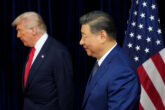March 10, 2022
The Tangled Web We Wove
Rebalancing America’s Supply Chains
Executive Summary
The pendulum of globalization has swung too far. What the fallout of the ongoing pandemic makes clear is that decades of offshoring and cost-cutting in the pursuit of efficiency and a better bottom line have left the supply chains of the United States and its allies and partners unacceptably brittle. Restoring balance to the system—with greater resilience through reducing dependence on potential adversaries, greater geographic diversity, and a pragmatic approach to building a mix of domestic capabilities and sourcing from reliable partners—will be a complex, expensive, and far-reaching undertaking. It could well reshape the global economy and strengthen ties between the world’s democracies, and is likely to be a key factor in determining the course of the global strategic competition.
Tackling America’s supply chain problems will require a new conceptual framework that is fit for the current geopolitical context. The United States and China are engaged in a complex economic, political, and military competition marked by sharp ideological and normative differences and economic dependencies. Global trade and supply chain dynamics reflect much of the spectrum of this competition, the overreliance on China for key inputs and manufacturing capacity most prominently. Correcting this imbalance and assuring the resilience and security required is needed to ensure long-term American competitiveness.
The framework with which to address that imbalance has three core elements: adjusting the role of government, checking the key assumptions that shaped current global supply chains, and balancing the tension between self-reliance and interdependencies. Policymakers and business leaders alike must rethink how government and industry engage each other on supply chain matters as part of a new form of industrial policy. For example, government officials need to better understand global supply chains to identify vulnerabilities and pursue opportunities. At the same time, company officers must strive for greater transparency and continuous supply chain assessments.
Restoring balance will require a new approach to thinking about the trade-offs between efficiency, reliability, availability, and security. No longer will the least expensive supply chain option necessarily be the most effective, nor will the highly optimized one always be the most desirable. Supply chain resilience often will require geographic diversity and surge capacity, principles that may clash with a company’s near-term bottom line.
Finally, a balance must be struck between the understandable desire to be self-sufficient and the realities of cost and feasibility. In most cases, autarky would be prohibitively expensive and not achievable because of the global diffusion of raw materials, technologies, know-how, and manufacturing capacity. Instead, policymakers should consider how to leverage allies and partners to establish more robust and secure supply chains.
This report offers a schema to help U.S. decision makers navigate those trade-offs by categorizing factors of necessity and geography. Using this schema as a baseline, government and industry leaders can shape a blueprint for remapping supply chains. The report then builds on that basic framework by offering specific actionable policy recommendations to ensure that the resulting U.S. supply chain strategy is comprehensive, proactive, and achievable.
Tackling America’s supply chain problems will require a new conceptual framework that is fit for the geopolitical context.
To promote more resilient and secure supply chains, the U.S. government must enact a range of policy actions. Cooperation with industry and allied and partner countries should be an essential feature of this strategy. The following recommendations comprise specific actions focused on bolstering the government’s ability to manage supply chains through greater organizational capacity and authorities. Also proposed are investments and initiatives that are likely to transform supply chains to the long-term benefit of U.S. national and economic security.
Manage Supply Chains
The White House, with the support of Congress, should:
- Craft a supply chain strategy. The United States needs a blueprint for how to think about, and prioritize, the security and resilience of its critical supply chains.
- Remap critical supply chains. Many supply chains important to U.S. economic security and national defense are dangerously brittle. Addressing these vulnerabilities will be expensive, complex, and time consuming. The risks of not restructuring these supply chains, however, are even greater.
- Institutionalize supply chain reviews. The U.S. government should institutionalize the use and frequency of supply chain reviews for critical sectors as part of a comprehensive framework to monitor and continuously improve supply chain resilience efforts.
- Engage with industry leaders and private sector partners on the development and implementation of supply chain restructuring. Policymakers and government officials must continue to engage private sector partners and leverage existing models of public-private partnerships when considering the restructuring or remapping of critical supply chains.
- Leverage existing federal legislation and regulations to incentivize and drive transformation beneficial to the U.S. economy and defense. U.S. executive agencies have the authority to enforce, as well as regulate through supervision authorities in critical infrastructure, critical sectors related to U.S. defense or economic security.
Congress, in consultation with relevant government agencies, should:
- Expand the use of existing industrial survey authorities. The Department of Commerce’s Bureau of Industry and Security (BIS) has the authority under section 705 of the Defense Production Act to conduct “industry studies assessing the U.S. industrial base to support the national defense.”1
- Promote efforts to improve software supply chain security. Existing governmental efforts to strengthen the resilience of supply chains should acknowledge and address software supply chain security.
- Evaluate vulnerabilities in U.S. stockpiles of critical materials and supplies for national defense. The U.S. government must prepare its strategic stockpiles for widespread disruption to global supply chains by increasing funding and resources for emergency preparedness and response.
- Encourage relevant government agencies to adopt emerging technologies, such as blockchain, to build transparency and accountability. Distributed ledger systems ensure transparency for all parties along a given supply chain by providing verifiable and certified information at every level of production.
- Identify, develop, and apply security principles for technologies in supply chains. As private industry continues to adopt emerging technologies such as 5G and Internet of Things infrastructure, cybersecurity concerns remain a persistent threat.2 Congress in consultation with the Federal Communications Commission should review relevant principles for ensuring safe and secure usage of these technologies throughout critical supply chains.
- Review and amend outdated provisions in the Uniform Commercial Code and others to optimize supply chain coordination. The governing legal standards for supply chains in the United States are based on the privity of contract doctrine, which prevents external parties and individuals from enforcing the obligations of a contract they are not a part of.
Transform Supply Chains
Congress should:
- Expand the mission of the Bureau of Industry and Security. BIS should assume authority to regulate and protect U.S. technology supply chains. It should be reorganized to model the Department of the Treasury’s Office of Terrorism and Financial Intelligence.3
- Create an assistant secretary of commerce for supply chain and technology security. This position would centralize the department’s policy and regulatory programs involving supply chain integrity, availability, and resilience, such as Defense Production Act programs, and planning and administration of BIS industry surveys.
Congress, in conjunction with the State Department and the White House, should:
- Establish a network of like-minded countries to collaborate on technology policy.4 Technology policy coordination among like-minded countries is often sporadic and disjointed. The United States should create a multilateral technology alliance with a core group of like-minded countries to collaborate on supply chain diversification.5
- Bolster U.S. capacity to conduct tech diplomacy. The United States needs a robust tech diplomacy capability to address the international dimensions of supply chains and technology competition more broadly.
The Department of Commerce should:
- Establish an information fusion center, headquartered in the International Trade Administration’s Office of Industry and Analysis. Anticipating and mitigating supply chain risk will require a permanent and dedicated effort to monitor and analyze developments in industry and actions by foreign governments that impact supply chain dynamics.
The National Science Foundation, in collaboration with relevant agencies, should:
- Invest in next-generation tools, platforms, and technologies for supply chain security. For example, AI tools hold great promise to improve supply chain management such as by analyzing vast data sets, enhancing understanding of relationships, and supporting decision-making.
Download the Full Report
- Bureau of Industry and Security, U.S. Department of Commerce, U.S. Industrial Base Surveys Pursuant to the Defense Production Act of 1950 (Washington: 2015), 41426, https://www.federalregister.gov/documents/2015/07/15/2015-17388/us-industrial-base-surveys-pursuant-to-the-defense-production-act-of-1950; Andrew J. Grotto, “U.S. Policy Toolkit for Kaspersky Labs,” Lawfare, March 15, 2018, https://www.lawfareblog.com/us-policy-toolkit-kaspersky-labs. ↩
- Matt O’Brien, “As robots take over warehousing, work- ers pushed to adapt,” Associated Press, December 30, 2019, https://apnews.com/article/connecticut-us-news-ap-top-news-az-state-wire-ct-state-wire-056b44f5bfff11208847aa9768f10757; Jean-Paul A. Yaacoub, Hassan N. Noura, Ola Salman, and Ali Chehab, “Robotics cyber security: vulnerabilities, attacks, countermeasures, and recommendations,” International Journal of Informa- tion Security, 2021, https://link.springer.com/content/pdf/10.1007/s10207-021-00545-8.pdf. ↩
- John Costello, Martijn Rasser, and Megan Lamberth, “From Plan to Action: Operationalizing a U.S. National Technology Strategy,” CNAS, July 29, 2021, https://www.cnas.org/publications/reports/from-plan-to-action. ↩
- Martijn Rasser and Megan Lamberth, “Taking the Helm: A National Technology Strategy to Meet the China Challenge,” CNAS, January 13, 2021, https://www.cnas.org/publications/reports/taking-the-helm-a-national-technology-strategy-to-meet-the-china-challenge. ↩
- Martijn Rasser, Rebecca Arcesati, Shin Oya, Ainikki Riikonen, and Monika Bochert, “Common Code: An Alliance Framework for Democratic Technology Policy,” CNAS, October 21, 2020, https://www.cnas.org/publications/reports/common-code. ↩
More from CNAS
-
Transatlantic Security / Technology & National Security
Look Before We Leap on Artificial IntelligenceThis article was originally published on The Dispatch. A debate about the role that artificial intelligence should and will play in society, and how it will affect humanity fo...
By Jon B. Wolfsthal
-
Technology & National Security
Caleb Withers on the Cybersecurity Frontier in the Age of AICaleb Withers, research associate at the Center for a New American Security, joins Kevin Frazier, the AI Innovation and Law Fellow at the University of Texas School of Law and...
By Caleb Withers
-
Technology & National Security
Prepared, Not ParalyzedExecutive Summary The Trump administration has embraced a pro-innovation approach to artificial intelligence (AI) policy. Its AI Action Plan, released July 2025, underscores t...
By Janet Egan, Spencer Michaels & Caleb Withers
-
Indo-Pacific Security / Technology & National Security
Sharper: Tech + ChinaRecent talks between President Donald Trump and Chinese Communist Party General Secretary Xi Jinping placed a spotlight on emerging technologies, from high-end chips to minera...
By Charles Horn & Sevi Silvia








